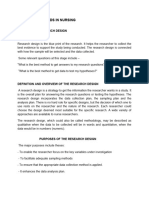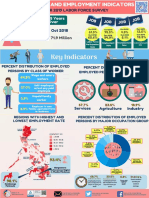0 ratings0% found this document useful (0 votes)
Research Design: By: Hazel Marianne L. Mariano
Research Design: By: Hazel Marianne L. Mariano
Uploaded by
george dan torresThis document discusses various research design methods, focusing on descriptive research designs. It describes several types of descriptive research designs including descriptive normative surveys, correlational research studies, descriptive evaluative studies, assessment/evaluation studies, and descriptive comparative studies. It also briefly discusses experimental research designs, historical research designs, sampling methods including probability and non-probability sampling techniques, considerations for sample size, and sampling techniques like simple random sampling and stratified random sampling.
Copyright:
© All Rights Reserved
Available Formats
Download as PPTX, PDF, TXT or read online from Scribd
Download as pptx, pdf, or txt
Research Design: By: Hazel Marianne L. Mariano
Research Design: By: Hazel Marianne L. Mariano
Uploaded by
george dan torres0 ratings0% found this document useful (0 votes)
This document discusses various research design methods, focusing on descriptive research designs. It describes several types of descriptive research designs including descriptive normative surveys, correlational research studies, descriptive evaluative studies, assessment/evaluation studies, and descriptive comparative studies. It also briefly discusses experimental research designs, historical research designs, sampling methods including probability and non-probability sampling techniques, considerations for sample size, and sampling techniques like simple random sampling and stratified random sampling.
Original Title
Research Design.pptx
Copyright
© © All Rights Reserved
Available Formats
PPTX, PDF, TXT or read online from Scribd
Share this document
Did you find this document useful?
Is this content inappropriate?
This document discusses various research design methods, focusing on descriptive research designs. It describes several types of descriptive research designs including descriptive normative surveys, correlational research studies, descriptive evaluative studies, assessment/evaluation studies, and descriptive comparative studies. It also briefly discusses experimental research designs, historical research designs, sampling methods including probability and non-probability sampling techniques, considerations for sample size, and sampling techniques like simple random sampling and stratified random sampling.
Copyright:
© All Rights Reserved
Available Formats
Download as PPTX, PDF, TXT or read online from Scribd
Download as pptx, pdf, or txt
0 ratings0% found this document useful (0 votes)
Research Design: By: Hazel Marianne L. Mariano
Research Design: By: Hazel Marianne L. Mariano
Uploaded by
george dan torresThis document discusses various research design methods, focusing on descriptive research designs. It describes several types of descriptive research designs including descriptive normative surveys, correlational research studies, descriptive evaluative studies, assessment/evaluation studies, and descriptive comparative studies. It also briefly discusses experimental research designs, historical research designs, sampling methods including probability and non-probability sampling techniques, considerations for sample size, and sampling techniques like simple random sampling and stratified random sampling.
Copyright:
© All Rights Reserved
Available Formats
Download as PPTX, PDF, TXT or read online from Scribd
Download as pptx, pdf, or txt
You are on page 1/ 44
RESEARCH DESIGN
By: Hazel Marianne L. Mariano
DESCRIPTIVE RESEARCH
DESIGNS
• describe the status of an identified variable such
as events, people or subjects as they exist
• make some type of comparison contrasts and
correlation and sometimes cause-effect
relationships may be established to some extent
Sound of
DESCRIPTIVE RESEARCH
DESIGNS
• Descriptive Normative Surveys:
- describe the trends in a large population of
individuals
- identify the trends in attitudes, opinions,
behaviors or characteristics
DESCRIPTIVE RESEARCH
DESIGNS
• Correlational Research Studies:
- estimate the extent to which different
variables are related to one another
- include identification of the variables, the
group of subjects where the variables will be
applied, and the estimation procedure to
determine the extent of relationships
DESCRIPTIVE RESEARCH
DESIGNS
• Correlational Research Studies:
- NOTE: If there is a significant relationship
between two variables, it does not follow that
one variable causes the other.
DESCRIPTIVE RESEARCH
DESIGNS
• Descriptive Evaluative Studies:
- judge the “goodness of a criterion measure”.
- Longitudinal studies establish the changes in
that criterion measure over a long period of
time.
DESCRIPTIVE RESEARCH
DESIGNS
• Descriptive Evaluative Studies:
- Cross-sectional studies are designed to
evaluate changes over time by comparing at
the same point in time, different people
representing different stages in the
development.
DESCRIPTIVE RESEARCH
DESIGNS
• Assessment/Evaluation Studies:
- attempt to determine the effectiveness or
efficiency of certain practices or policies when
applied to a group of respondents
DESCRIPTIVE RESEARCH
DESIGNS
• Assessment/Evaluation Studies:
- Assessment studies imply measurement of key
indicators without attaching any judgment
- Evaluation studies imply putting judgment and
valuing to the measurements obtained
DESCRIPTIVE RESEARCH
DESIGNS
• Descriptive Comparative Studies:
- establish significant differences between two
or more groups of subjects on the basis of a
criterion measure
- no attempts to control the effects of
extraneous factors are made
EXPERIMENTAL RESEARCH
DESIGNS
• are also known as longitudinal or repeated-
measures studies
• use the scientific method to establish the cause-
effect relationship among a group of variables
that make up a study
EXPERIMENTAL RESEARCH
DESIGNS
• An independent variable is manipulated to
determine the effects on the dependent
variables.
• Subjects are randomly assigned to experimental
treatments.
EXPERIMENTAL RESEARCH
DESIGNS
• An enormous difference between the descriptive
method of research and experimental method of
research is the presence of control in the latter
design.
HISTORICAL RESEARCH
DESIGNS
• to collect, verify, and synthesize evidence from
the past to establish facts that defend or refute
your hypothesis
• uses secondary sources and variety of primary
documentary evidence
HISTORICAL RESEARCH
DESIGNS
• logs, diaries, official records, reports, archives,
and non-textual information like maps, pictures,
audio and visual recordings
• sources must be both authentic and valid
SAMPLING
• process of getting information from a proper
subset of population
• describe the population characteristics through
the values obtained from a sample as accurately
as possible
SAMPLING PLAN
• detailed outline of which measurements will be
taken at what times, on which material, in what
manner, and by whom that support the purpose
of an analysis
SAMPLE SIZE
• Given a population frame, the first question a
researcher often asks is the question of sample
size.
• The Slovin’s formula may be applied: n =
N/(1+Ne2) where N = population size and e =
error balance.
-n
SAMPLING TECHNIQUES
• Probability Sampling
- samples are obtained using objective chance
mechanism, thus involving randomization
- only approach that makes possible
representative sampling plans
SAMPLING TECHNIQUES
• Non-probability sampling is a technique when
there is no way of estimating the probability that
each element has of being included in the
sample and no assurance that every element has
a chance of being included.
PROBABILITY SAMPLING
• Simple random sampling:
- each member of the sample is selected by the
equivalent draw lots
- sample is selected in two ways: by a table of
random numbers or by the lottery technique
PROBABILITY SAMPLING
• Systematic random sampling:
- uses a list of elements of the population as a
sampling frame and the elements to be
included in the desired sample are selected by
skipping
- starting point to be taken is a random choice.
PROBABILITY SAMPLING
• Systematic random sampling:
- Use the formula k = N/n where k = sampling
interval, N = population size and n = number of
samples needed.
PROBABILITY SAMPLING
• Stratified random sampling
- population is first divided into strata and then
samples are randomly selected separately
from each stratum
- number of units drawn from each stratum
depends on the ratio of the desired sample in
the population (n/N)
PROBABILITY SAMPLING
• Clustered random sampling
- entire population is broken into small groups,
or clusters, then some of the clusters are the
ones that are analyzed
NON-PROBABILITY
SAMPLING
• Accidental or convenience sampling
- the investigator reaches out and takes the
cases that are at hand, continuing the process
until the sample reaches a designated size
NON-PROBABILITY
SAMPLING
• Accidental or convenience sampling
- also known as “the man on the street”
interviews
- lack of evidence that they are the
representatives of the population you are
interested in generalizing
NON-PROBABILITY
SAMPLING
• Purposive sampling or judgment sampling
- used when practical consideration prevent the
use of probability sampling
- you sample with a purpose in mind.
NON-PROBABILITY
SAMPLING
• Purposive sampling or judgment sampling
- from judgmental samples at best indicate
conclusions but in general they cannot be used
as the basis of statistical testing procedures
NON-PROBABILITY
SAMPLING
• Snowball sampling
- identifies cases of interest from people who
know other people who would be a good
interview participant
ta
You might also like
- Chapter 1 - Nature of Inquiry and Research100% (10)Chapter 1 - Nature of Inquiry and Research50 pages
- Research Design and Methods: DR Brian Van Wyk Post-Graduate Enrolment and ThroughputNo ratings yetResearch Design and Methods: DR Brian Van Wyk Post-Graduate Enrolment and Throughput16 pages
- Course 5 - Research Design - Sampling DesignNo ratings yetCourse 5 - Research Design - Sampling Design46 pages
- Quantitative Research Design and Sampling MethodsNo ratings yetQuantitative Research Design and Sampling Methods20 pages
- CRIM-7-8-Criminological-Research-1-2 (2)No ratings yetCRIM-7-8-Criminological-Research-1-2 (2)132 pages
- Lesson 4 - Quantitative Research Designs and Sampling TechniquesNo ratings yetLesson 4 - Quantitative Research Designs and Sampling Techniques35 pages
- 4. Understanding Data and Ways to Systematically Collect DataNo ratings yet4. Understanding Data and Ways to Systematically Collect Data64 pages
- Definition, Characteristics, and Types of QuantitativeNo ratings yetDefinition, Characteristics, and Types of Quantitative25 pages
- NW-Research Methods For Business Students Part 2No ratings yetNW-Research Methods For Business Students Part 216 pages
- Ers5900 Week 67 Quantitative Research.1No ratings yetErs5900 Week 67 Quantitative Research.160 pages
- Methods of Research AND Procedures: Prepared By: Josefina T. Parreño, R.N. Joahne P. Tipay, R.NNo ratings yetMethods of Research AND Procedures: Prepared By: Josefina T. Parreño, R.N. Joahne P. Tipay, R.N22 pages
- Powerpoint Presentation Research Daily Life 2 1No ratings yetPowerpoint Presentation Research Daily Life 2 172 pages
- 4. 定量研究方法简介 An Introduction to Quantitative Research MethodsNo ratings yet4. 定量研究方法简介 An Introduction to Quantitative Research Methods50 pages
- Inquiries, Investigation, and Immersion (3is) Reviewer: PopulationNo ratings yetInquiries, Investigation, and Immersion (3is) Reviewer: Population5 pages
- J Public Adm Res Theory-1993-Bozeman-273-304No ratings yetJ Public Adm Res Theory-1993-Bozeman-273-30432 pages
- CHAPTER I: Nature of Inquiry and ResearchNo ratings yetCHAPTER I: Nature of Inquiry and Research16 pages
- Chapter 6: Finding Answers Through Data Collection: By: Hazel Marianne L. MarianoNo ratings yetChapter 6: Finding Answers Through Data Collection: By: Hazel Marianne L. Mariano12 pages
- CHAPTER I: Nature of Inquiry and ResearchNo ratings yetCHAPTER I: Nature of Inquiry and Research16 pages
- Comparison of Qualitative Methods: Method Study Focus Analytic Focus DisciplinesNo ratings yetComparison of Qualitative Methods: Method Study Focus Analytic Focus Disciplines1 page
- CHAPTER 6: Finding Answers Through Data Collection, Analyzing The Meaning of Data and Drawing ConclusionsNo ratings yetCHAPTER 6: Finding Answers Through Data Collection, Analyzing The Meaning of Data and Drawing Conclusions2 pages
- Research Ethics: Hazel Marianne L. MarianoNo ratings yetResearch Ethics: Hazel Marianne L. Mariano35 pages
- Instrumentation: By: Hazel Marianne L. Mariano100% (1)Instrumentation: By: Hazel Marianne L. Mariano52 pages
- Chapter 5: Data Collection: By: Hazel Marianne L. MarianoNo ratings yetChapter 5: Data Collection: By: Hazel Marianne L. Mariano21 pages
- Chapter 6: Finding Answers Through Data Collection: By: Hazel Marianne L. MarianoNo ratings yetChapter 6: Finding Answers Through Data Collection: By: Hazel Marianne L. Mariano12 pages
- CHAPTER 5: Understanding Data and Ways To Systematically Collect DataNo ratings yetCHAPTER 5: Understanding Data and Ways To Systematically Collect Data3 pages
- Chapter 3: Stating The Problem: By: Hazel Marianne L. MarianoNo ratings yetChapter 3: Stating The Problem: By: Hazel Marianne L. Mariano14 pages
- CHAPTER 4: Review of Related Literature: Ilocos Norte College of Arts and TradesNo ratings yetCHAPTER 4: Review of Related Literature: Ilocos Norte College of Arts and Trades4 pages
- Chapter 3: Stating The Problem: By: Hazel Marianne L. MarianoNo ratings yetChapter 3: Stating The Problem: By: Hazel Marianne L. Mariano48 pages
- Chapter 4: Review of Related Literature: By: Hazel Marianne L. MarianoNo ratings yetChapter 4: Review of Related Literature: By: Hazel Marianne L. Mariano45 pages
- Chapter I: Nature of Inquiry and Research: By: Hazel Marianne L. MarianoNo ratings yetChapter I: Nature of Inquiry and Research: By: Hazel Marianne L. Mariano17 pages
- Chapter 2: Qualitative Research: By: Hazel Marianne L. MarianoNo ratings yetChapter 2: Qualitative Research: By: Hazel Marianne L. Mariano34 pages
- Chapter I: Nature of Inquiry and Research: By: Hazel Marianne L. MarianoNo ratings yetChapter I: Nature of Inquiry and Research: By: Hazel Marianne L. Mariano27 pages
- CHAPTER 2: Qualitative Research and Its Importance in Daily LifeNo ratings yetCHAPTER 2: Qualitative Research and Its Importance in Daily Life5 pages
- Chapter I: Nature of Inquiry and Research: By: Hazel Marianne L. MarianoNo ratings yetChapter I: Nature of Inquiry and Research: By: Hazel Marianne L. Mariano35 pages
- Molar Incisor Hypomineralization (MIH) : Clinical Presentation, Aetiology and ManagementNo ratings yetMolar Incisor Hypomineralization (MIH) : Clinical Presentation, Aetiology and Management4 pages
- Automatic Street Lights On Motion Control: A Project Report OnNo ratings yetAutomatic Street Lights On Motion Control: A Project Report On20 pages
- A Level Mathematics C3 and C4 Revision NotesNo ratings yetA Level Mathematics C3 and C4 Revision Notes3 pages
- Emulating Web Services and RPCs With Copaiva (By Anthony Ferrara, Dayle Rees, and Taylor Otwell)No ratings yetEmulating Web Services and RPCs With Copaiva (By Anthony Ferrara, Dayle Rees, and Taylor Otwell)6 pages
- Punjab Technical University: April 13 & 14, 2012No ratings yetPunjab Technical University: April 13 & 14, 20122 pages
- (U) Daily Activity Report: Marshall DistrictNo ratings yet(U) Daily Activity Report: Marshall District5 pages
- A Stacked Multi-Connection Simple Reducing Net ForNo ratings yetA Stacked Multi-Connection Simple Reducing Net For14 pages
- Labview Core 2 Instructor Guide: November 2014No ratings yetLabview Core 2 Instructor Guide: November 201453 pages
- Fractals in Sound Patterns of Sanskrit Mantras and Its Use in Healing Therapy June 2022 7666551745 3607796No ratings yetFractals in Sound Patterns of Sanskrit Mantras and Its Use in Healing Therapy June 2022 7666551745 36077964 pages
- How To Form Strain-Gage Bridges: Circuit Application Sample Name Output Bridge Box DB-120A/350A RemarksNo ratings yetHow To Form Strain-Gage Bridges: Circuit Application Sample Name Output Bridge Box DB-120A/350A Remarks2 pages
- Top 41 SAP Security Interview Questions and AnswersNo ratings yetTop 41 SAP Security Interview Questions and Answers6 pages
- Beyond The Walls of Bloodborne Gothic TRNo ratings yetBeyond The Walls of Bloodborne Gothic TR69 pages
- Research Design and Methods: DR Brian Van Wyk Post-Graduate Enrolment and ThroughputResearch Design and Methods: DR Brian Van Wyk Post-Graduate Enrolment and Throughput
- Lesson 4 - Quantitative Research Designs and Sampling TechniquesLesson 4 - Quantitative Research Designs and Sampling Techniques
- 4. Understanding Data and Ways to Systematically Collect Data4. Understanding Data and Ways to Systematically Collect Data
- Definition, Characteristics, and Types of QuantitativeDefinition, Characteristics, and Types of Quantitative
- Methods of Research AND Procedures: Prepared By: Josefina T. Parreño, R.N. Joahne P. Tipay, R.NMethods of Research AND Procedures: Prepared By: Josefina T. Parreño, R.N. Joahne P. Tipay, R.N
- 4. 定量研究方法简介 An Introduction to Quantitative Research Methods4. 定量研究方法简介 An Introduction to Quantitative Research Methods
- Inquiries, Investigation, and Immersion (3is) Reviewer: PopulationInquiries, Investigation, and Immersion (3is) Reviewer: Population
- Chapter 6: Finding Answers Through Data Collection: By: Hazel Marianne L. MarianoChapter 6: Finding Answers Through Data Collection: By: Hazel Marianne L. Mariano
- Comparison of Qualitative Methods: Method Study Focus Analytic Focus DisciplinesComparison of Qualitative Methods: Method Study Focus Analytic Focus Disciplines
- CHAPTER 6: Finding Answers Through Data Collection, Analyzing The Meaning of Data and Drawing ConclusionsCHAPTER 6: Finding Answers Through Data Collection, Analyzing The Meaning of Data and Drawing Conclusions
- Chapter 5: Data Collection: By: Hazel Marianne L. MarianoChapter 5: Data Collection: By: Hazel Marianne L. Mariano
- Chapter 6: Finding Answers Through Data Collection: By: Hazel Marianne L. MarianoChapter 6: Finding Answers Through Data Collection: By: Hazel Marianne L. Mariano
- CHAPTER 5: Understanding Data and Ways To Systematically Collect DataCHAPTER 5: Understanding Data and Ways To Systematically Collect Data
- Chapter 3: Stating The Problem: By: Hazel Marianne L. MarianoChapter 3: Stating The Problem: By: Hazel Marianne L. Mariano
- CHAPTER 4: Review of Related Literature: Ilocos Norte College of Arts and TradesCHAPTER 4: Review of Related Literature: Ilocos Norte College of Arts and Trades
- Chapter 3: Stating The Problem: By: Hazel Marianne L. MarianoChapter 3: Stating The Problem: By: Hazel Marianne L. Mariano
- Chapter 4: Review of Related Literature: By: Hazel Marianne L. MarianoChapter 4: Review of Related Literature: By: Hazel Marianne L. Mariano
- Chapter I: Nature of Inquiry and Research: By: Hazel Marianne L. MarianoChapter I: Nature of Inquiry and Research: By: Hazel Marianne L. Mariano
- Chapter 2: Qualitative Research: By: Hazel Marianne L. MarianoChapter 2: Qualitative Research: By: Hazel Marianne L. Mariano
- Chapter I: Nature of Inquiry and Research: By: Hazel Marianne L. MarianoChapter I: Nature of Inquiry and Research: By: Hazel Marianne L. Mariano
- CHAPTER 2: Qualitative Research and Its Importance in Daily LifeCHAPTER 2: Qualitative Research and Its Importance in Daily Life
- Chapter I: Nature of Inquiry and Research: By: Hazel Marianne L. MarianoChapter I: Nature of Inquiry and Research: By: Hazel Marianne L. Mariano
- Molar Incisor Hypomineralization (MIH) : Clinical Presentation, Aetiology and ManagementMolar Incisor Hypomineralization (MIH) : Clinical Presentation, Aetiology and Management
- Automatic Street Lights On Motion Control: A Project Report OnAutomatic Street Lights On Motion Control: A Project Report On
- Emulating Web Services and RPCs With Copaiva (By Anthony Ferrara, Dayle Rees, and Taylor Otwell)Emulating Web Services and RPCs With Copaiva (By Anthony Ferrara, Dayle Rees, and Taylor Otwell)
- A Stacked Multi-Connection Simple Reducing Net ForA Stacked Multi-Connection Simple Reducing Net For
- Fractals in Sound Patterns of Sanskrit Mantras and Its Use in Healing Therapy June 2022 7666551745 3607796Fractals in Sound Patterns of Sanskrit Mantras and Its Use in Healing Therapy June 2022 7666551745 3607796
- How To Form Strain-Gage Bridges: Circuit Application Sample Name Output Bridge Box DB-120A/350A RemarksHow To Form Strain-Gage Bridges: Circuit Application Sample Name Output Bridge Box DB-120A/350A Remarks
- Top 41 SAP Security Interview Questions and AnswersTop 41 SAP Security Interview Questions and Answers



















































































































